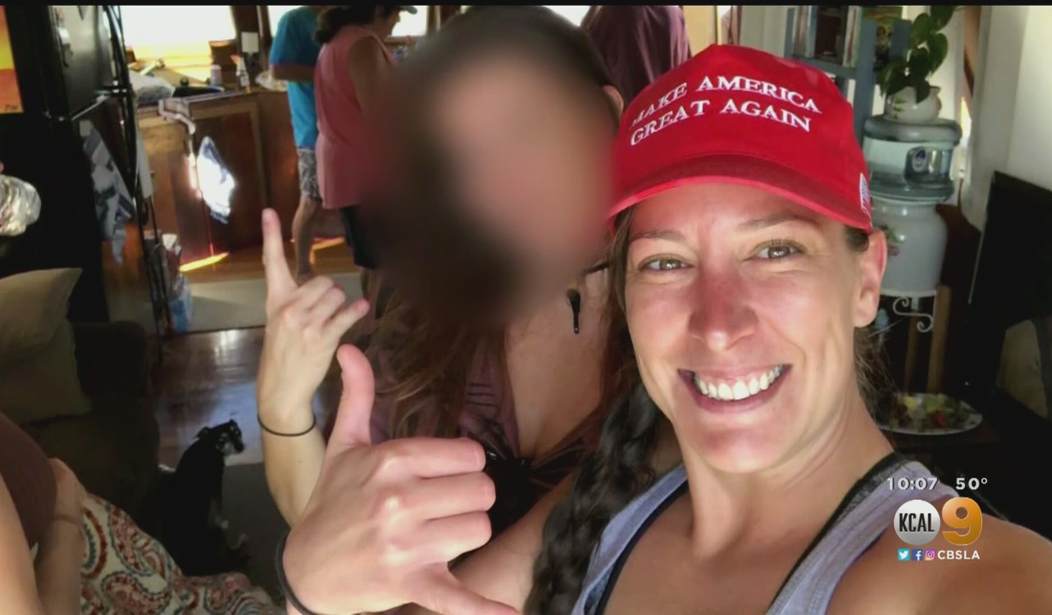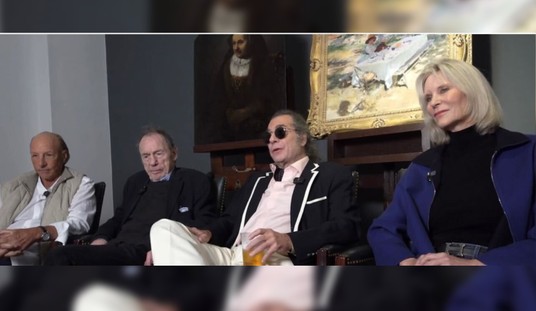At last he speaks. We now know what has long been an open secret, that it was Lt. Michael Byrd of the U.S. Capitol Police who shot and killed Ashli Babbitt on Jan. 6. In his interview with NBC’s Lester Holt, Byrd was inconsistent in his grasp of the facts, self-contradictory, and ill-informed on the law governing police use of force. If this is how he performed under Holt’s gentle questioning, it’s easy to speculate on how he would hold up under cross-examination by a competent and even mildly aggressive attorney, and I am more confident than ever that the government will settle with Babbitt’s family rather than risk a trial featuring Byrd as the key witness.
Understand that it is not only Byrd himself who will be accused in the wrongful death suit yet to be filed. His department will also be named when the suit is brought in the jurisdiction the plaintiffs choose, and in speaking with Holt, Byrd exposed some departmental deficiencies a jury may see as having contributed to Babbitt’s death. For example, Byrd says his assigned detail, which was dedicated to protecting the House Chamber, was operating at about one-third of its customary manpower on Jan. 6, this due to COVID protocols and the need to divert officers to the demonstration. Byrd was comfortable with this, he tells Holt, because his department had not received “specific intel that would require us to change or adjust our posture.”
This is not to suggest Byrd himself was responsible for the lack of advance information or for personnel decisions, but people above him in his chain of command certainly were. And surely there were those within the myriad agencies of the federal security apparatus who knew the crowd would be large and that some people within it were potentially violent. Was this information relayed to the Capitol Police? If not, why not, and if so, why wasn’t it acted upon?
Byrd also spoke of the confusion and his own lack of information in the moments leading up the shooting. Through his police radio and in emails he received on his phone, he heard the reports that rioters had breached the Capitol and that officers were being injured. “There was reports of shots fired through the House main door,” he says, “onto the floor of the Chamber.” He later learned that report was unfounded, but in that moment this information understandably affected his thinking.
Recommended: CNN Uses Ashli Babbitt to Paint Trump Supporters As Terrorists
The situation was chaotic, surely, and Byrd took appropriate action by using furniture to barricade the doors leading to the Speaker’s Lobby. He says there were two or three other officers with him at the time, which prompts an important question: Where were those officers when Byrd shot Babbitt? He talks of the information he received via radio and cell phone, but at no time does he mention any directions he gave to subordinates. Byrd is a lieutenant, and presumably there were officers under his command he could have summoned to his aid. If Byrd truly saw himself as the last line of defense between a murderous mob and the senators, congressmen, and staffers gathered in the House Chamber, why did he not redirect the resources necessary to repel the attack?
Byrd also contradicts himself in the interview, and this contradiction will be damning in the civil action to come. He tells Holt the people in the House Chamber were “essentially trapped,” which would seem to imply that the doorways to the Speaker’s Lobby were their only avenues of escape. But later in the interview, he talks about evacuating the House Chamber after shooting Babbitt. “I immediately went to try to provide a safe route for an evacuation for the members of Congress,” he says, “and advise them which way to go and how to proceed.” He will find it difficult to explain this contradiction in a deposition or in front of a jury.
Some members of Congress, Byrd says, had limited mobility, and he was worried for their safety because they could not move as quickly as others. “Some of those members,” he says, “were directly in the Lobby with me at the time of the incident.” If this is so, why is it not evident in the only publicly available video of the incident? In that video, available here, at the Washington Post website, only one man can be seen at the far end of the Speaker’s Lobby at the time Byrd fired the fatal shot, and that man has no readily apparent restrictions on his mobility.
As the video shows, moments before the shooting, three uniformed police officers are standing at the doorway to the Speaker’s Lobby and blocking the rioters from passing. Inexplicably, they move to the side and allow the rioters to attack the doors, with one rioter finally breaking the window through which Babbitt would attempt to climb. Byrd says he had no way of communicating with those officers, or with the tactical team that arrived seconds later. What was the failure, either by Byrd himself or by members of his department, that prevented him from communicating with these officers, who were better situated to assess the threat that Byrd erroneously believed to be so dire?
Some of Byrd’s statements to Holt are plainly contradicted by the video. Byrd claims he was unable to see what was happening outside the doorway because the windows were blocked by the impromptu barricade he and the other officers had erected. Yet in the video, shot by one of the rioters, people in the Speaker’s Lobby are plainly visible, so much so that the Washington Post identifies one of them as Rep. James P. McGovern (D, Mass.). Byrd himself can be seen through the window in the moments before and when he fired the fatal shot. How can he now claim he was unable to see through the same window?
Recommended: Cop Who Shot Ashli Babbitt Said He ‘Showed the Utmost Courage’ on January 6th
Byrd also claimed he was shouting at Babbitt to stop and get back before firing, shouting so loudly, in fact, that his “throat was hurting for a few days afterward.” There is no evidence of any such shouting in the video, though it’s possible it was drowned out by shouts from the rioters. Presumably, there is security video from within the Speaker’s Lobby that captured Byrd’s warnings, if they in fact occurred.
Finally, we come to Byrd’s explanation for the shooting itself. “What made you pull the trigger?” Holt asks. “Last resort,” Byrd replies. “I tried to wait as long as I could . . . but their failure to comply required me to take the appropriate action . . .”
Then comes the portion of the interview that surely had government lawyers gasping in horror. “Because the call of shots fired had went out,” Byrd says, “you know, it was later I found out that the subject did not have a weapon, but there was no way to know that at that time. And I could not fully see her hands or what was in the backpack or what the intentions of. But they had shown violence leading up to that point.”
Byrd thus makes the remarkable admission that he heard vague reports that unknown and undescribed individuals in a large crowd had behaved violently, and that he relied on those reports in deciding to fire on a slightly built woman who was neither armed nor holding anything he might reasonably have mistaken for a weapon.
“Does it matter,” Holt then asks, “if the person was armed or not?”
“According to law,” Byrd says, “it does not. And I would let my lawyer speak on that or the United States Capitol Police general counsel further elaborate on that. I know based on my training and my policy, what I did was appropriate.”
With this, Byrd displays an inadequate grasp of the law regarding police use of force. The landmark U.S. Supreme Court case on point is Graham v. Connor (1989), which held that any force used by police must be judged by a standard of “objective reasonableness.” Byrd’s judgment at the time he fired was that if he failed to do so, the mob would overrun the House Chamber and do harm to the people inside. But note that the reasonableness test in Graham demands that an officer using deadly force must have a reasonable belief the suspect “poses an immediate threat to the safety of the officers or others.”
By his own admission, there were avenues of escape available to those in the House Chamber, avenues Byrd himself guided them through after shooting Babbitt. What’s more, there was one other person visible in the Speaker’s Lobby at the time Byrd shot Babbitt, and that man was at least fifty feet away from the doors where the rioters had gathered. How did the unarmed Babbitt pose an immediate threat to this man, to anyone in the House Chamber, or to Byrd himself? Yes, Byrd’s intentions were good, but as Chief Justice Rehnquist wrote for the majority in Graham, “An officer’s evil intentions will not make a Fourth Amendment violation out of an objectively reasonable use of force; nor will an officer’s good intentions make an objectively unreasonable use of force constitutional.”
In the NBC interview, Byrd presented himself as conscientious and well-meaning, but most police officers can readily recognize him for what he is: a long-serving middle manager of modest abilities, one who should be nowhere near any situation requiring split-second, life-and-death decisions. It was a bad shooting, and no amount of spin can make it otherwise. Babbitt’s family will prevail in their civil suit, as they should.









Join the conversation as a VIP Member